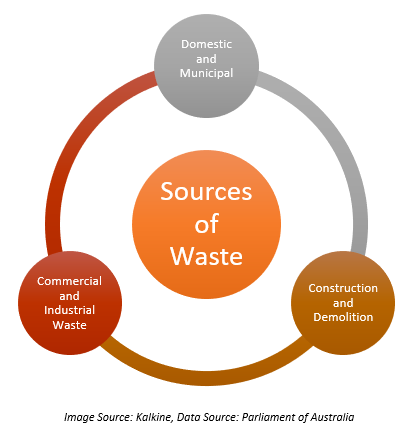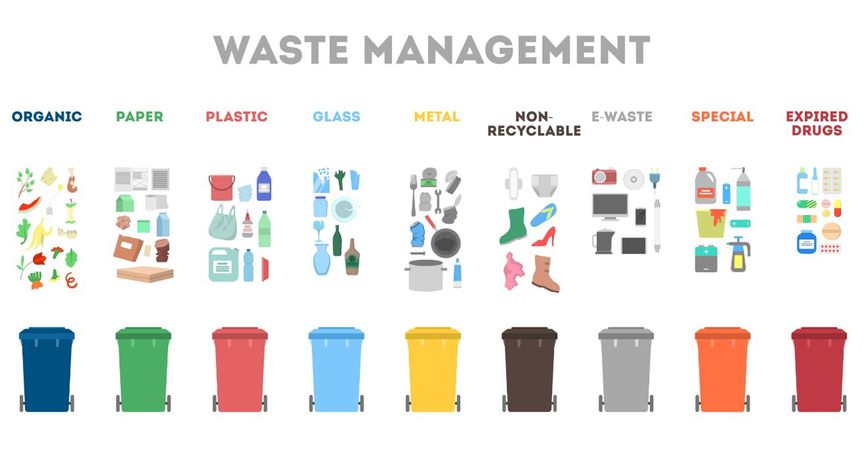Summary
- Waste refers to the materials or products that have been discarded as they are no longer needed.
- Domestic & municipal, construction & demolition, and commercial & industrial waste are three major sources of waste in Australia.
- The government would also infuse AU$249.6 million over four years (starting 2020–2021 to aid local waste management, reduce environmental pressure, and establish economic opportunities for the residents.
Waste refers to the materials or products that have been discarded as they are no longer needed. Waste involves materials or products that are recycled, transformed to energy, or disposed. However, products that are reused do not fall under this category as they are used without reprocessing.
In Australia, the three major sources of waste include construction & demolition, commercial & industrial waste, and domestic & municipal.

Australia’s Waste Statistics
As per the most recent release by the Australian Bureau of Statistics on 06 November 2020, Australia generated 76 million tonnes of waste in 2018-19, up 10% since 2016-17. The country spent AU$17 billion on waste management during this period.
The sectors that generated maximum waste were:
Manufacturing: Generated 12.8 million tonnes in 2018-19 (16.9%).
Construction: Generated 12.7 million tonnes in 2018-19 (16.8%).
Households: Generated 12.4 million tonnes of waste in 2018-19 (16.3%).
Electricity, gas, and water services: Generated 10.9 million tonnes of waste in 2018-19 (14.4%).

How does Australia manage waste?
In Australia, city councils take care of the garbage, recyclables, and FOGO deals for collecting garbage, recyclables, glass, and FOGO and give education initiatives to encourage recycling opportunities, waste reduction, and enhance the city's deviation from landfill.
INTERESTING READ: Cleanaway Waste Management (ASX:CWY) likely to buy Suez’s local assets
Progress against the targets in the policy plan
Waste generation is directly linked to the population size, household income, along with economic activity within the country.
In 2018, the Australian Government, state and territory governments as well as the Australian Local Government Association established the updated National waste policy that aims to aid Australia to move closer to a more circular economy that removes waste & improves economic, social & environmental results.
Below were some of the targets in the National Waste Policy Action Plan:
- Ban the export of waste plastic, paper, glass and tyres from 2H CY2020.
- Average resource recovery rate of 80% from waste streams by 2030 as per the waste hierarchy.
- Reduce total waste generated by 10% per individual by 2030.
- Drastically boost the usage of recycled content by governments and industry.
- By 2025, phase out challenging and unwarranted plastics.
- By 2030, reduce the amount of organic waste sent to landfills.
- Make comprehensive data widely accessible on time to assist enhanced customer, policy, and investment decisions.
Budget to support domestic waste management
In the Federal budget, the government declared an outlay of AU$249.6 million over 48 months (starting 2020-2021) to aid local waste management, lower environmental pressure as well as create economic opportunities for the residents.
The investment made by the Commonwealth is a component of the national strategy to change Australia's waste and recycling industry. It includes:
- AU$190 million to form a Recycling Modernisation Fund. The fund, along with the contributions from the states and territories and industry, is anticipated to yield AU$600 million of recycling investment to drive change of the country's waste & recycling capability.
- Another AU$35 million for Commonwealth's commitments, according to the National Waste Policy Action Plan. This action plan sets the path for waste management as well as recycling in Australia up to 2030.
- The government would enhance Australian national waste data to assess recycling results and keep an eye on the progress made against the national waste targets.
- AU$10.0 million would be spent from 2020–21 over four years to help industry-led collaborative research plans.
- Another AU$184.7 million for developing national guidelines and model specifications for the usage of recycled items while constructing roads.
DO WATCH: The Early Trades || What are the key highlights from Australia’s Federal Budget 2021-22?



